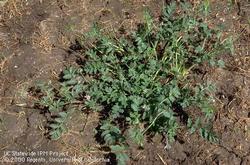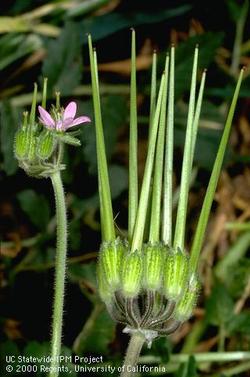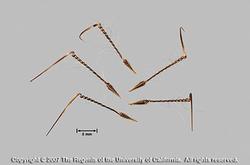Filaree Winter Annual "weed"
The best time to control filaree weeds (hint: NOW- after first rain)
by Kate Cummings
By fall, most gardeners have done mountains of weeding and are ready to close up shop for the year. But now is actually the best time to control winter annual weeds like filaree. Winter annuals need attention because they germinate now and flower, spread seed, and die quickly in spring before we even know they’re there. And filaree weeds deserve a little extra attention because they leave behind dried plant debris that injure pets. This debris causes painful cuts that can lead to infection or worse for pets and distress and expense for owners. But early detection and common-sense weed control steps will help you protect your pets and your landscape.
What is filaree?
Filaree (Erodium spp.) are members of the geranium family and include whitestem (E. moshatum), redstem (E. cicutarium) and broadleaf (E. botrys) filaree. They are also called stork’s bill. Filaree grow in disturbed soils in lawns, planting beds, roadsides, parking strips, and fields.
Filaree reproduces only by seed. In fall, seeds germinate and grow slowly overwinter as rosettes. Flowers and distinctive fruit appear in early spring. In late spring/early summer, fruits dry out and seed is released by a spring mechanism or ‘awn’ that drills the seed into the ground. Once the seed is buried, the broken awn lies in wait for unsuspecting paws. Buried seeds can survive in the soil for 1 – 3 years creating a ‘seed bank’. Disturbing soil that has a ‘seed bank’ can cause flushes of filaree germination and growth.
Photos of filaree development by season

|

|

|
| Late fall/early winter - seedlings emerge and develop into low-lying, slow-growing rosettes. | Late winter/spring- 4” shoots of purple/pink flowers (L) and green fruit with seeds (R) emerge quickly | Late spring/early summer - the seeds and awns dry out and prepare to eject. Yikes. |
Control steps
To get control of filaree, keep them from releasing their seeds and keep last year’s seed bank buried. To do that, use a combination of well-timed and effective control steps that minimize harm to people, pets, and the environment. Here’s how:
- Remove them when they’re young - it’s easier! Seedlings emerge after the first fall rains (photo 1). At this point, hand weeding is easy thanks to tender stems, shallow roots, and moist soils. Shallow (< 1”) hoeing and tilling can be effective when soils are a bit drier. Mowing rosettes doesn’t work well because they’re too low to the ground.
- Get rid of them before they release their seeds - this keeps awns (In botany, an awn is either a hair-like or bristle-like appendage structure) away from your pets and saves you a lot of work in the future! If you missed the rosettes, flowers and green fruit (photo 2) are easy to spot in spring. Hand weeding and hoeing are still great options but expect stronger roots and drier soil. You can cut off flower heads and green fruit to give yourself more time before they dry out but aim to remove the entire taproot to prevent new stalks. All plant material should be placed in municipal green recycling and not home compost.
- Minimize soil disturbance - digging and cultivating can bring up buried seeds from last year. When weeding, use a sharp, narrow tool (a hori hori knife, an old steak knife) - you’ll get the root without excess soil. When hoeing, try not to dig too deep - just deep enough (< 1”) to cut the root below the soil surface.
- Mulch your landscape including areas where you just weeded. Thick mulch (2-3”) smothers the upstarts by keeping sunlight and warmth from reaching seeds and young seedlings.
- Avoid the void - cover bare patches of soil in your yard. Mulching, replanting, reseeding, or using cover crops will improve the quality of your soil and reduce weeds. Closely spaced plantings can also help shade soil surfaces and choke weeds out.
- Take a regular walk around your yard. Depending on temperature and rainfall, filaree seeds can germinate at different times. A stroll through the garden is one of life’s pleasures and will give you the chance to spot and remove new filaree when they’re young.
Over a few seasons, these steps will likely be all you need to do. But if these steps fail and the problem remains extensive, you can consider chemical controls like herbicides. Check out the resources below and/or contact the Help Desk to help you decide whether herbicides are actually needed and how to choose the safest, most-effective options. And, consider other non-chemical alternatives like sheet mulching that can turn even the most stubborn, large patches of weeds into plantable spaces. See the links below to learn more about sheet mulching and drought-tolerant native plantings.
With a little weeding and garden maintenance now, your pets can enjoy a safe romp in the summer yard - and they’ll love you even more.
Links to additional information
Filaree info and pictures at various life stages:
- http://ipm.ucanr.edu/PMG/WEEDS/filarees.html
- http://hortsense.cahnrs.wsu.edu/Search/MainMenuWithFactSheet.aspx?CategoryId=6&ProblemId=2048
Weed management Filaree:
Weed management in landscapes:
Weed management in lawns:
Mulch:
Herbicides:
Sheet mulching video:
Lawn replacement options:
Native/drought-tolerant plants:
Still Need Help?
Would you like more information or help with other gardening issues? Email us at acmg@ucanr.edu. Or contact us through our website http://acmg.ucanr.edu/Contact_Us/ .

